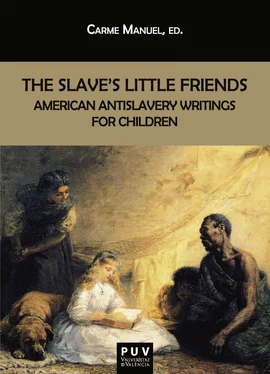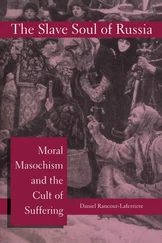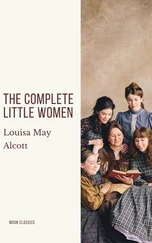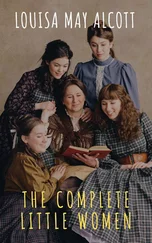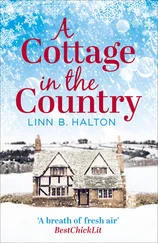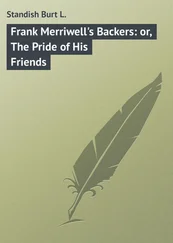It is crucial to remember that American abolitionist writers of children’s literature could look backwards across the Atlantic and drew inspiration and example from relevant British antislavery traditions, which had already deployed vivid images and language to attack slavery through the medium of juvenile literature since the second half of the eighteenth century. The fame of revered male but also female writers such as William Cowper, Thomas Day, Ann Laetitia Barbauld, Mary Edgeworth or Amalia Opie, among many others, inspired American writers to establish their own attitudes and understandings of bondage at home, and provided them with a respectable tradition from which to cull new perspectives. The transatlantic print culture made it possible for English writers to be reprinted, quoted and appropriated by American authors who had access to this antislavery material not only in their original editions, but also thanks to the numberless reprints in American magazines and newspapers, as Gould explains, “sometimes completely, sometimes partially, and sometimes even deliberately bowdlerized, with only the poem’s title to catch the eye of the perusing reader” (191). By 1830, when American abolitionists set themselves to the systematic task of producing texts for children, “British antislavery poetry was already part of American literary culture, and the abolitionists marshaled it for their own political purposes” (Gould 191). For radical abolitionists slavery was the worst of sins. In fact, the system was conceived in their rhetoric as a mirror reflecting their own degradation, and understood as one of the most fearful and corrupting influences on American children.
Yet, the recognition of American abolitionist writings for children as an outstanding literary field to understand antebellum politics and uncompromising conceptions of childhood is not unanimous among scholars. In White Supremacy in Children’s Literature: Characterizations of African Americans, 1830-1900 (2001), Donnarae MacCann, for example, dismisses these texts because “[e]ven though radical White abolitionists tried to prick the American conscience vis-à-vis slavery, many of their books would have injured the self-esteem of Blacks (and inflated the egos of European Americans) in about the same degree as proslavery texts.” For this researcher, the language of white supremacy throughout the antebellum decades resounded so loudly that “the underlying message was audible in most white abolitionist writings—the message that European cultural values would always be the exclusive measure of what was best” (22). Her point of view leads readers to discard practically all types of written texts in antebellum America literature, to say the least. Yet, as Clare Bradford notes, one of the functions of children’s literature is “to explain and interpret national histories—histories that involve invasion, conquest, violence, and assimilation” (97). Consequently, American abolitionist writings for children stand as relevant and controversial pieces in the national historical puzzle.
Paula Connolly defines radical abolitionist literature for children as representing slavery in the United States as “an unquestionably cruel system under which people suffered tremendous injustices” and which “often argued for racial equality and called for an immediate end to slavery” (15). The abolitionist writings for children published by American authors emerged out of the American context and the debates that the system spawned throughout the first half of the nineteenth century. As historian David Brion Davis (215) explains, the political and economic magnitude of slavery in the United States justifies the different orientations of its significance on both sides of the Atlantic Anglo-world. Whereas British abolitionists followed a far more establishment-oriented direction, American radical abolitionists placed themselves in direct confrontation with a national government keen on maintaining a political compromise with the slave-owning Southern states. Consequently, abolitionists were considered to be dangerous fanatics that questioned the sacrosanct basis of American antebellum societal norms. In the 1820s, at a time when the first calls for an independent American literature were first issued, children’s literature became an important field for American writers to be targeted. As explained above, American women were soon called up for the literary antislavery war and, specifically, for the juvenile trenches.
In 1824 Lydia Maria Child wrote about the urgent need for women to address juvenile audiences. In her Evenings in New England: Intended for Juvenile Amusement and Instruction , she recognized the risks involved in coming before the public, and paid homage to the British women’s contributions to children’s literature, especially by luminaries such as Maria Edgeworth and Anna Letitia Barbauld. Child, however, believed that “[e]xcellent as those books are, they are emphatically English; and I indulged the hope that American scenes, and American characters, would give a delightful locality to the following stories, though they could not boast of such simple elegance of expression, or such pointed purity of moral” (iii).
Even if the antislavery movement was a transatlantic phenomenon, scholars such as Richard S. Newman state that “abolitionism was born with the American republic. It did not fade until the nation’s near-death experience of the Civil War. Yet while abolitionists worked consistently to destroy slavery and racial injustice in these years, their strategy and tactics constantly evolved” (2). Hence, the evolution and changes in the American abolitionist movement in tactics and strategies had a projection on the literary field and on antislavery literature for children. Moreover, these texts necessarily reflected the development of political events, as well as the economic necessities, the intellectual aspirations, the literary ambitions and the political activism of their authors. As Paula Connolly emphasizes, “the presentation of abolitionist sentiment in children’s literature was neither ideologically cohesive nor uniformly critical” (14). Consequently, the texts included in this anthology will be divided into three broad groups: antislavery writings, composed during the decade of the 1820s; radical abolitionist texts, published during the decades of the 1830s and 1840s; and post- Uncle Tom ’s texts, written after the phenomenal reception of Harriet Beecher Stowe’s Uncle Tom’s Cabin in 1850-1851.
Antislavery writings for children: the 1820s
During the first three decades of the nineteenth century, Americans believed that slavery was not a central issue in national politics and its existence went mainly unnoticed within the field of children’s literature. On the one hand, they were convinced that a process of gradual emancipation would be successful, and, on the other, that the South would eventually mirror the North by a process of slow but steady abolition in the different states. The colonization project (the encouragement to relocate free blacks in Liberia, the settlement of the American Colonization Society on the western coast of Africa) justified the humanitarian impulse that undergirds desires for emancipation.
The first two texts presented in this anthology were written by women not related to the antislavery struggles, yet both build around the figure of the black woman as an old individual, an antecedent of the thriving character of the black mammy. The story that might be the first to inaugurate a long list of American antislavery works for children is “ OLD BETTY,” a piece written by Margaret Bayard Smith (1778-1844) and included in her children’s book American Mother (1823). The book came out in the same year that English writer Eliza Farrar published The Adventures of Congo in Search of His Master; an American Tale (London: John Harris), a title that had numerous editions in the United States. In 1805 Smith had already published another children’s story called The Diversions of Sidney . American Mother was a cheap-print book, over three by five inches (Teute 1996: 41), which was followed by a two-volume novel titled A Winter in Washington, or Memoirs of the Seymour Family (1824), and several other works, which culminated in Smith’s most widely recognized work, The First Forty Years of Washington Society , a collection of her letters and notebooks from 1800 to 1841, published in 1906 by Gaillard Hunt, an American historian and editor, chief of the division of manuscripts in the Library of Congress from 1909 to 1917, who also edited James Madison’s writings. Smith belonged to the Washingtonian political and social elite of her time, and in contrast to the period’s gender expectations, she became deeply involved in the public life of the early Republic through her writings. Yet, as Fredrika Teute explains, she was never involved in any antislavery association, a fact that did not stop her from writing about black and white relationships and made her become “one of the earliest and one of the few authors to write on the topic for the next generation” (1996: 55).
Читать дальше
